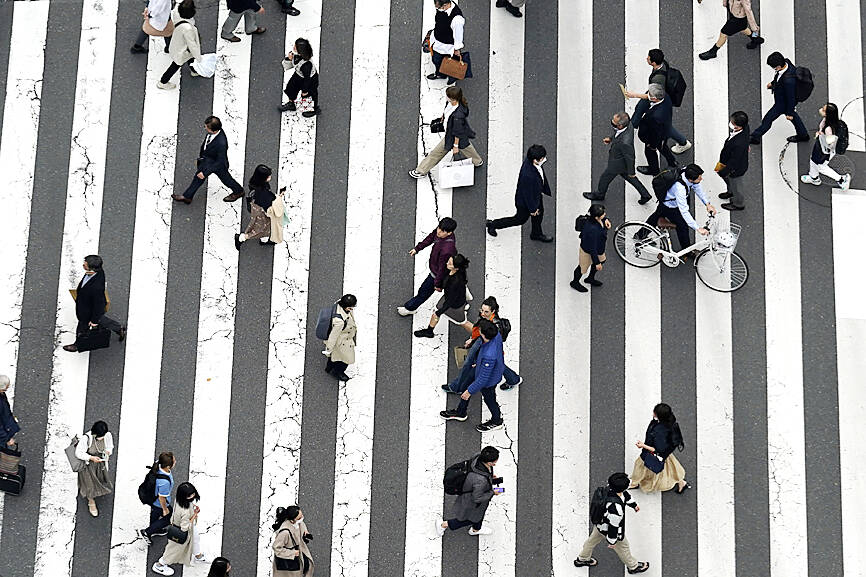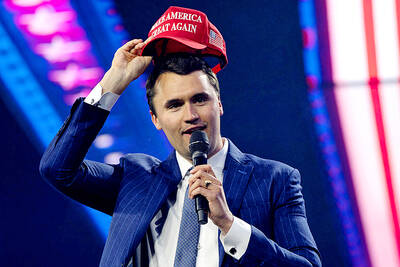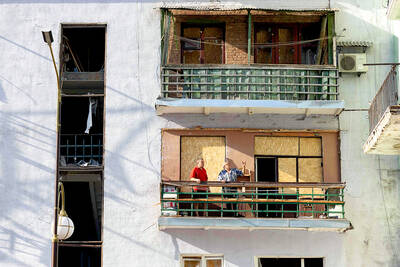Every one of Japan’s 47 prefectures posted a population drop last year, while the total number of Japanese people fell by more than 800,000.
The figures released yesterday by the Japanese Ministry of Internal Affairs and Communications mark two new unwelcome records for a nation sailing into uncharted demographic territory, but on a course many other countries are set to follow.
Japan’s prime minister has called the trend a crisis and vowed to tackle the situation, but national policies have so far failed to dent population decline, although concerted efforts by a sprinkling of small towns have had some effect.

Photo: AP
The new data showed deaths hit a record high of more than 1.56 million, while there were just 771,000 births in Japan last year, the first time the number of newborns has fallen below 800,000 since records began.
Even an all-time high increase in foreign residents of more than 10 percent, to 2.99 million, could not halt a slide in the total population, which has declined for 14 years in a row to 122.42 million last year.
In January, Japanese Prime Minister Fumio Kishida said that addressing the birthrate was “now or never,” adding that “our nation is on the cusp of whether it can maintain its societal functions.”
Japan’s aging population is already affecting nearly every aspect of society. More than half of all municipalities are designated as depopulated districts, schools are closing and more than 1.2 million small businesses have owners aged about 70 with no successor.
Programs on the broadcast satellite channels are geared to an older audience, with the commercials a procession of offerings for funeral services, supplements to relieve aching joints and incontinence pads.
Japan’s underworld has not escaped unscathed either. A majority of yakuza are older than 50 and there are more gangsters in their 70s than in their 20s. Meanwhile, senior porn is a growing niche, populated by a handful of silver stars in their 60s, 70s and even 80s.
On April 1, Japan launched the Children and Families Agency, bringing all related issues, including the birthrate, under one entity. The government has also pledged to double spending on childcare and allowances to 4 percent of GDP, but childcare and education subsidies implemented in the past have had little effect on the birthrate.
Despite this, about 300 small towns have significantly boosted births through a combination of generous payouts and policies to create more child-friendly environments.
Municipalities offering the best deals to new parents almost certainly benefited from migration from other areas by those already planning to have families.
Although even Nagi in Okayama Prefecture — which became something of a poster child for increasing the number of children born — has seen its birthrate dip slightly in the past few years. Japan is far from alone in having fewer babies.
The average fertility rate for the Organisation for Economic Co-operation and Development group of wealthy nations is 1.66, well below the replacement rate of 2.1 required to maintain population numbers.
Although Japan’s population started to fall before that of other countries — peaking in 2008 — declines in fertility rates have been more precipitous elsewhere, particularly in East Asia.
Taiwan is just below Japan with 1.24 babies per woman, while neighboring South Korea has the world’s lowest rate at just 0.78.

‘HYANGDO’: A South Korean lawmaker said there was no credible evidence to support rumors that Kim Jong-un has a son with a disability or who is studying abroad South Korea’s spy agency yesterday said that North Korean leader Kim Jong-un’s daughter, Kim Ju-ae, who last week accompanied him on a high-profile visit to Beijing, is understood to be his recognized successor. The teenager drew global attention when she made her first official overseas trip with her father, as he met with Chinese President Xi Jinping (習近平) and Russian President Vladimir Putin. Analysts have long seen her as Kim’s likely successor, although some have suggested she has an older brother who is being secretly groomed as the next leader. The South Korean National Intelligence Service (NIS) “assesses that she [Kim Ju-ae]

In the week before his fatal shooting, right-wing US political activist Charlie Kirk cheered the boom of conservative young men in South Korea and warned about a “globalist menace” in Tokyo on his first speaking tour of Asia. Kirk, 31, who helped amplify US President Donald Trump’s agenda to young voters with often inflammatory rhetoric focused on issues such as gender and immigration, was shot in the neck on Wednesday at a speaking event at a Utah university. In Seoul on Friday last week, he spoke about how he “brought Trump to victory,” while addressing Build Up Korea 2025, a conservative conference

DEADLOCK: Putin has vowed to continue fighting unless Ukraine cedes more land, while talks have been paused with no immediate results expected, the Kremlin said Russia on Friday said that peace talks with Kyiv were on “pause” as Ukrainian President Volodymyr Zelenskiy warned that Russian President Vladimir Putin still wanted to capture the whole of Ukraine. Meanwhile, US President Donald Trump said that he was running out of patience with Putin, and the NATO alliance said it would bolster its eastern front after Russian drones were shot down in Polish airspace this week. The latest blow to faltering diplomacy came as Russia’s army staged major military drills with its key ally Belarus. Despite Trump forcing the warring sides to hold direct talks and hosting Putin in Alaska, there

North Korea has executed people for watching or distributing foreign television shows, including popular South Korean dramas, as part of an intensifying crackdown on personal freedoms, a UN human rights report said on Friday. Surveillance has grown more pervasive since 2014 with the help of new technologies, while punishments have become harsher — including the introduction of the death penalty for offences such as sharing foreign TV dramas, the report said. The curbs make North Korea the most restrictive country in the world, said the 14-page UN report, which was based on interviews with more than 300 witnesses and victims who had